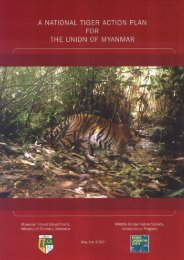Download - Global Tiger Initiative
Download - Global Tiger Initiative
Download - Global Tiger Initiative
You also want an ePaper? Increase the reach of your titles
YUMPU automatically turns print PDFs into web optimized ePapers that Google loves.
from Russia in the 1920s has been estimated to have amounted to about 1000 pelts a year<br />
(Heptner and Sludskii, 1972; Fox, 1989). Certainly, hunting levels have been high in places<br />
during the twentieth century. Bannikov (1954) estimated that up to 80 Snow Leopards a year<br />
were hunted in the first decade of the twentieth century in Mongolia, though this number had<br />
dropped to 15-50 animals in the middle of the century (Hibbert, 1967). In the Kirghiz Soviet<br />
Socialist Republic (now Kyrgyzstan) almost 40 Snow Leopards a year were trapped between<br />
1953 and 1963 and about 30 a year from the 1960s to the 1980s, after which the number soared<br />
during the 1990s (see Kyrgyzstan in following chapter).<br />
Pelts from Snow Leopards were in demand during much of the twentieth century, for decorative<br />
reasons, for garments and as a sign of wealth and status in general. Snow Leopard skins have<br />
been presented as 'State gifts' among world leaders (Chestin, 1998; Dexel, 2002). The fur has<br />
also been used in traditional religious dresses in the Tibet Autonomous Region. The skins<br />
appear to be the primary reason for killing Snow Leopards for trade in the present day. The<br />
recent TRAFFIC report Far From A Cure: the <strong>Tiger</strong> Trade Revisited noted a rise in the trade of<br />
Asian big cat skins, including those of Snow Leopards, although this phenomenon is not<br />
adequately understood (Nowell, 2000).<br />
Leopard bones, including Snow Leopard bones, have been used in traditional Asian medicines<br />
for centuries for a variety of treatments, including rheumatism, tendonitis and bone fractures<br />
(Bensky and Gamble, 1993). They are considered to have acrid and warm properties and to<br />
have anti-inflammatory and pain-relieving effects (Anon., 1994). In the Chinese materica<br />
medica they are referred to as Bao Gu or Os leopardi and their properties are distinguished from<br />
those of <strong>Tiger</strong> bones, although they can be used as a substitute for the latter (Bensky and<br />
Gamble, 1993). The skulls of Snow Leopards have also been used in ritual ceremonies in parts<br />
of China and in Nepal (G. Gurung, WWF Nepal, in litt., 2002) and body parts other than bones,<br />
including the sexual organs, teeth, claws and meat appear in trade, for medicine and shamanistic<br />
practices (Khan, 2002a). In recent years, anecdotal reports from a number of range States have<br />
indicated an increase in the demand for Snow Leopard bones (McCarthy and Chapron, 2003).<br />
This increase is likely to be related to the stricter enactment and enforcement of wildlife trade<br />
controls for <strong>Tiger</strong>s in a number of range and consumer States in the mid-1990s, which may have<br />
shifted trade to other big cat species (Nowell, 2000).<br />
Hundreds of live Snow Leopards were traded during the twentieth century. The majority of<br />
these animals, exported to supply zoos, originated from what is now Kyrgyzstan and Tajikistan.<br />
Reports suggest that an average of 12 live Snow Leopards a year were exported by the former<br />
until the early 1970s, and up to 425 live specimens by the latter, between 1937 and 1969<br />
(Heptner and Sludskii, 1972).<br />
Occasional advertisements testify to present-day, international, illegal trade in Snow Leopards<br />
(in addition to the seizures reported in Box 1). A Snow Leopard skin rug was offered for sale<br />
in the Jakarta Post, an Indonesian daily newspaper in English, in September 2001 (C. Shepherd,<br />
TRAFFIC Southeast Asia, in litt., 2002) and the German Society for Nature Conservation<br />
(NABU) reported a Snow Leopard skin coat (priced at USD100) and stuffed Snow Leopard<br />
advertised on e-bay, an internet-based trading site, in November 2002 and March 2003, respectively.<br />
The range State accounts following provide ample evidence of the illegal hunting and<br />
trade at the source of such international trafficking in Snow Leopard products.<br />
FADING FOOTPRINTS: the killing and trade of Snow Leopards 25

















